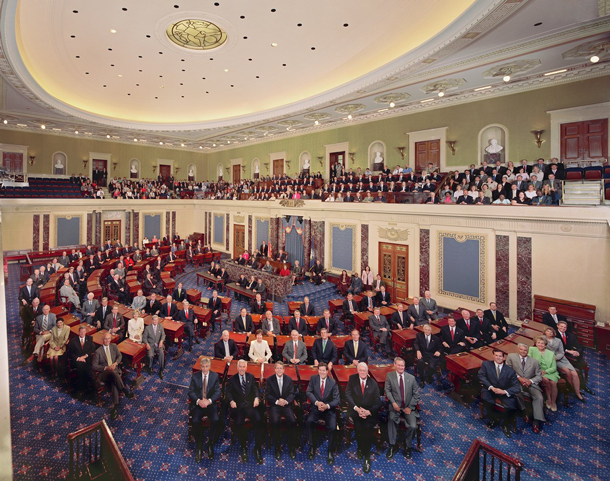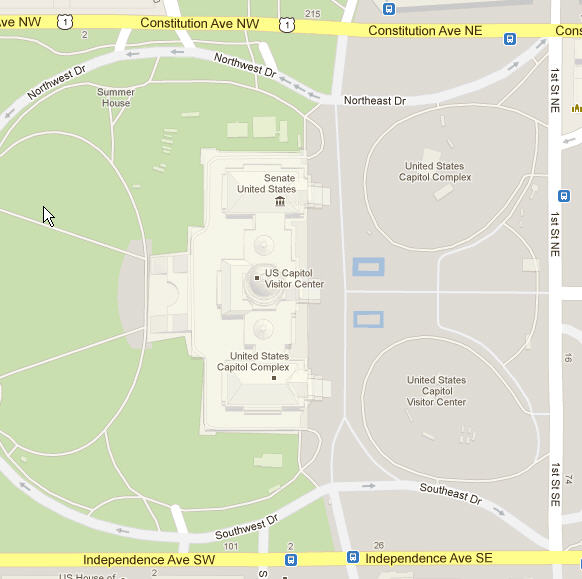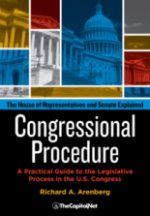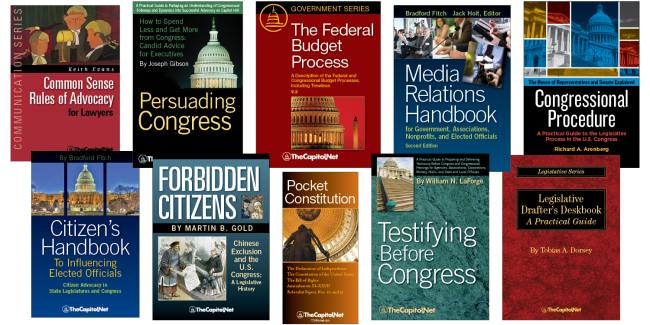From the Congressional Glossary – Including Legislative and Budget Terms
Senate

The Senate, as distinct from the House of Representatives, although each body is a “house” or “chamber” of Congress. Established by the Constitution, Article I, Section 3. The size of the Senate, currently 100 members, is established by the Constitution (“The Senate of the United States shall be composed of two Senators from each State….”). Each member of the Senate is called “Senator”.

The Senate chamber and Senate Office Buildings are on the north side of the Capitol.
See “A Note About Usage: ‘Congress’.”
When members of the Senate and Senate staff speak of “the other body,” they are speaking of the House.
Also see A Note About Usage, “Congress”; Congressional Leadership and Committees; Filibuster; House; Impeach / Impeachment; President of the Senate; Senate Chamber; Senate Classes; Senate Floor; Senate Journal; Senate Manual; Senate Office Buildings (SOB); Senate Rules (Senate); Senate Salaries and Perquisites; Senator; Senatorial Courtesy; Treaties; § 5.70 Senate Leadership, § 6.04 Selected Procedures: House and Senate Rules, § 6.150 House and Senate Compared, § 6.180 Senate Calendars and Legislative and Executive Business before the Senate, § 6.210 Consideration and Debate on the Senate Floor, § 6.250 Voting in the Senate, § 11.20 How to Follow Floor Proceedings in the Senate, in Congressional Deskbook; Chapter 5. Senate Floor, in Congressional Procedure.
More
- Senate
- Congress by the Numbers
- Congress Seating Charts
- Congressional Schedule
- Congress Profile: The Backgrounds and Groups Among Members of Congress
- “The seven stages of the office seeker“
- “The First Day of a New Congress: A Guide to Proceedings on the Senate Floor,” CRS Report RS20722 (14-page PDF
 )
) - “Supreme Court Nominations, 1789 to 2020: Actions by the Senate, the Judiciary Committee, and the President,” CRS Report RL33225 (58-page PDF
 )
) - “Evolution of the Senate’s Role in the Nomination and Confirmation Process: A Brief History,” CRS Report RL31948 (19-page PDF
 )
) - “Supreme Court Nominations: Senate Floor Procedure and Practice, 1789-2011,” CRS Report RL33247 (53-page PDF
 )
) - “Senate Administrative Officers and Officials,” CRS Report 98-418 (4-page PDF
 )
) - “Presiding Officer: Senate,” CRS Report RS21553 (5-page PDF
 )
) - “Expulsion and Censure Actions Taken by the Full Senate Against Members,” CRS Report 93-875 (35-page PDF
 )
) - “How Measures Are Brought to the Senate Floor: A Brief Introduction,” CRS Report RS20668 (10-page PDF
 )
) - “Senate Floor Procedure: A Summary,” CRS Report 97-368 (53-page PDF
 )
)
Courses
- Congressional Operations Briefing – Capitol Hill Workshop
- Drafting Federal Legislation and Amendments
- Writing for Government and Business: Critical Thinking and Writing
- Custom Training
- Preparing and Delivering Congressional Testimony and Oral Presentations, a Five-Course series on CD
- Congress, the Legislative Process, and the Fundamentals of Lawmaking Series, a Nine-Course series on CD
Publications

Testifying Before Congress |

Pocket Constitution |

Citizen’s Handbook to Influencing Elected Officials: A Guide for Citizen Lobbyists and Grassroots Advocates |

Congressional Procedure |
CongressionalGlossary.com, from TheCapitol.Net
For more than 40 years, TheCapitol.Net and its predecessor, Congressional Quarterly Executive Conferences, have been teaching professionals from government, military, business, and NGOs about the dynamics and operations of the legislative and executive branches and how to work with them.
Our custom on-site and online training, publications, and audio courses include congressional operations, legislative and budget process, communication and advocacy, media and public relations, testifying before Congress, research skills, legislative drafting, critical thinking and writing, and more.
TheCapitol.Net is on the GSA Schedule, MAS, for custom on-site and online training. GSA Contract GS02F0192X
TheCapitol.Net is now owned by the Sunwater Institute.
Teaching how Washington and Congress work ™

